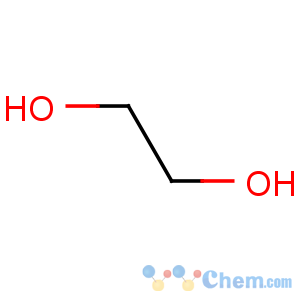Title: Ethylene Glycol
CAS Registry Number: 107-21-1
CAS Name: 1,2-Ethanediol
Molecular Formula: C2H6O2
Molecular Weight: 62.07
Percent Composition: C 38.70%, H 9.74%, O 51.55%
Line Formula: HOCH2CH2OH
Literature References: Prepd on a large scale by the hydration of ethylene oxide. Flowsheets:
Ullmanns Encyklop?die der technischen Chemie vol. 3 (3rd ed., 1953) p 137; M. Sittig,
Organic Chemical Process Encyclopedia (Noyes Dev. Corp., Park Ridge, N.J., 1967) p 265. Manuf from ethylene and oxygen:
Faith, Keyes & Clark's Industrial Chemicals, F. A. Lowenheim, M. K. Moran, Eds. (Wiley-Interscience, New York, 4th ed., 1975) pp 397-402. Toxicity studies: Smyth
et al., J. Ind. Hyg. Toxicol. 23, 259 (1941); Bornmann,
Arzneim.-Forsch. 4, 643 (1954). Monograph: G. O. Curme, F. Johnston,
Glycols (Reinhold, New York, 1952). GC/MS determn in plasma: C. Giachetti
et al., Biomed. Environ. Mass Spectrom. 18, 592 (1989). Review of toxicology and human exposure:
Toxicological Profile for Ethylene Glycol and Propylene Glycol (PB98-101108, 1997) 250 pp.
Properties: Slightly viscous liq. Sweet taste.
Poisonous! Do not swallow! Considerably hygroscopic: Absorbs twice its weight of water at 100% relative humidity. d40 1.1274. d410 1.1204. d420 1.1135. d430 1.1065. One gallon weighs 9.3 lbs. Flash pt, open cup: 240°F (115°C). mp -13°. bp760 197.6°; bp97 140°; bp18 100°; bp3.0 70°; bp0.06 20°.
nD15 1.43312;
nD25 1.43063. Viscosity (cP): 26 (15°); 21 (20°); 17.3 (25°). Dielectric constant at 20° and 150 meters wavelength: 38.66 esu. Dipole moment 2.20. Spec heat (20°): 0.561 cal/g/°C. Heat of formation -108.1 kcal/mol. Heat of fusion 44.7 cal/g. Heat of vaporization 191 cal/g. Heat of soln -6.5 cal/g of soln at 17° when 37 parts are mixed with 63 parts H2O (w/w). Parachor 148.9 (theory 152.2). Surface tension at 20° = 48.4 dynes/cm. Miscible with water, lower aliphatic alcohols, glycerol, acetic acid, acetone and similar ketones, aldehydes, pyridine and similar coal tar bases. Slightly sol in ether (1:200). Practically insol in benzene and its homologs, chlorinated hydrocarbons, petr ether, oils. Density and freezing point of ethylene glycol-water mixtures: 10.15% ethylene glycol by wt d2020 1.013, fp -3.5°; 20.44% ethylene glycol d2020 1.027, fp -8°; 29.88% ethylene glycol d2020 1.040, fp -15°; 40.23% ethylene glycol d2020 1.054, fp -24°; 50.18% ethylene glycol d2020 1.067, fp -36°; 58.37% ethylene glycol d2020 1.0770, fp -48°. LD50 in rats, guinea pigs (g/kg): 8.54, 6.61 orally (Smyth); in mice (ml/kg): 13.79 orally (Bornmann).
Melting point: mp -13°
Boiling point: bp760 197.6°; bp97 140°; bp18 100°; bp3.0 70°; bp0.06 20°
Flash point: Flash pt, open cup: 240°F (115°C)
Index of refraction: nD15 1.43312;
nD25 1.43063
Density: d40 1.1274; d410 1.1204; d420 1.1135; d430 1.1065; d2020 1.013, fp -3.5°; 20.44% ethylene glycol d2020 1.027, fp -8°; 29.88% ethylene glycol d2020 1.040, fp -15°; 40.23% ethylene glycol d2020 1.054, fp -24°; 50.18% ethylene glycol d2020 1.067, fp -36°; 58.37% ethylene glycol d2020 1.0770, fp -48°
Toxicity data: LD50 in rats, guinea pigs (g/kg): 8.54, 6.61 orally (Smyth); in mice (ml/kg): 13.79 orally (Bornmann)
CAUTION: Potential symptoms of overexposure by ingestion are nausea, vomiting, abdominal pain, weakness; dizziness, stupor, convulsions, CNS depression. Direct contact may cause irritation of eyes, nose, skin; skin sensitization.
See NIOSH Pocket Guide to Chemical Hazards (DHHS/NIOSH 97-140, 1997) p 136.
See also Patty's Industrial Hygiene and Toxicology vol. 2F, G. D. Clayton, F. E. Clayton, Eds. (Wiley-Interscience, New York, 4th ed., 1994) pp 4645-4657.
Use: Antifreeze in cooling and heating systems. In hydraulic brake fluids and de-icing solutions. Industrial humectant. Ingredient of electrolytic condensers (where it serves as solvent for boric acid and borates). Solvent in the paint and plastics industries. In the formulation of printers' inks, stamp pad inks, ball-point pen ink. Softening agent for cellophane. Stabilizer for soybean foam used to extinguish oil and gasoline fires. In the synthesis of safety explosives, glyoxal, unsatd ester type alkyd resins, plasticizers, elastomers, synthetic fibers (Terylene, Dacron), and synthetic waxes. To create artificial smoke and mist for theatrical uses.

